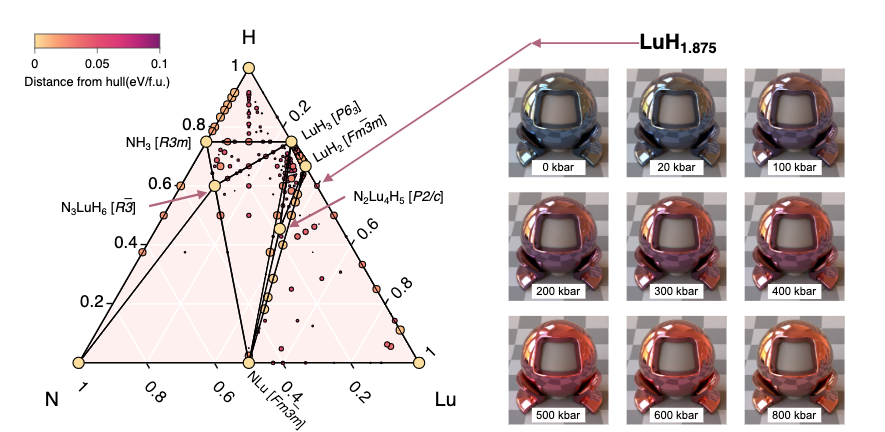
Submitted by Lewis Conway on Tue, 19/12/2023 - 17:24
Superconducting materials have a wide range of applications - from efficient power transmission to the advanced electromagnetics used in MRI machines - due to their loss-free conductivity. Current practical superconductors only exhibit these remarkable properties at temperatures below the so-called critical temperature Tc, which means that practical applications require expensive cooling with liquid helium or nitrogen. An ambitious goal in material science is to identify a material which has a Tc above room temperature.
One proposed route to room-temperature superconductivity is through hydrogen. It has long been theorised that metallic hydrogen formed at high pressure (above 500 GPa - more than the pressure at the centre of Earth) could be a superconductor. In recent years, researchers have succeeded in observing high-temperature superconductivity in hydrogen-based compounds at lower pressures, albeit still typically over 100 GPa.
A recent work from an experimental group in Rochester, USA, claimed the synthesis of a room-temperature superconducting Lu-N-H compound at near-ambient pressure. The onset of superconductivity was reported to have been associated with a characteristic change in the sample colour: blue-violet to pink, red, and eventually orange. Subsequent efforts to reproduce this result showed varying colour effects but failed to replicate the superconductivity. Both superconductivity and colour are consequences of the specific crystal structure and chemical composition of a material.
In this work, a team from the Materials Theory Group in the Department and international collaborators used a range of computational techniques to understand this system. First, machine-learned interatomic potentials were used to survey the Lu-N-H composition space for candidate crystal structures. The approach was successful in finding stable structures on the convex hull. Second, detailed electronic structure calculations of Lu-N-H compounds shed light on the observed colour changes. The microscopic theory of colour in lutetium hydride revealed that hydrogen-deficient LuH2 is the only phase which exhibits colour changes under pressure consistent with experimental reports, with a sequence blue-violet-pink-red-orange. The concentration of hydrogen vacancies controls the precise sequence and pressure of colour changes, rationalising seemingly contradictory experiments. Although nitrogen doping also modifies the colour of LuH2, it plays a secondary role compared to hydrogen vacancies. Finally, calculations reveal that neither the stable Lu-H-N compounds nor the pink phase of LuHx are room temperature superconductors.
As the field of superconducting hydrides rapidly evolves, it is clear that computational approaches have a crucial role to play in the identification of feasible superconducting materials and their properties.
Pedro P. Ferreira, Lewis J. Conway, Alessio Cucciari, Simone Di Cataldo, Federico Giannessi, Eva Kogler, Luiz T. F. Eleno, Chris J. Pickard, Christoph Heil & Lilia Boeri ‘Search for ambient superconductivity in the Lu-N-H system’, Nat Commun, vol. 14, no. 1, p. 5367, Sep. 2023, doi: 10.1038/s41467-023-41005-2.
S.W. Kim, L. J. Conway, C. J. Pickard, G. L. Pascut, and B. Monserrat, ‘Microscopic theory of colour in lutetium hydride’, Nat Commun, vol. 14, no. 1, p. 7360, Nov. 2023, doi: 10.1038/s41467-023-42983-z.

